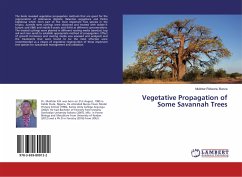Michael Bollig
Shaping the African Savannah
Schade – dieser Artikel ist leider ausverkauft. Sobald wir wissen, ob und wann der Artikel wieder verfügbar ist, informieren wir Sie an dieser Stelle.
Michael Bollig
Shaping the African Savannah
- Gebundenes Buch
- Merkliste
- Auf die Merkliste
- Bewerten Bewerten
- Teilen
- Produkt teilen
- Produkterinnerung
- Produkterinnerung
A history of 150 years of social-ecological transformations in the arid savannah landscape of Namibia.
Andere Kunden interessierten sich auch für
![Forest landscape along the roads - shaping possibilities Forest landscape along the roads - shaping possibilities]() Emilia JaneczkoForest landscape along the roads - shaping possibilities46,99 €
Emilia JaneczkoForest landscape along the roads - shaping possibilities46,99 €![Shaping Future Agriculture in Salt Affected Areas Shaping Future Agriculture in Salt Affected Areas]() Chaudhari SKShaping Future Agriculture in Salt Affected Areas59,99 €
Chaudhari SKShaping Future Agriculture in Salt Affected Areas59,99 €![Cattle feeding of Fulani pastoralists on savannah rangelands Cattle feeding of Fulani pastoralists on savannah rangelands]() Jonas André DjènontinCattle feeding of Fulani pastoralists on savannah rangelands59,99 €
Jonas André DjènontinCattle feeding of Fulani pastoralists on savannah rangelands59,99 €![The Big Book of Raising Chickens for Beginners The Big Book of Raising Chickens for Beginners]() Zelene WardThe Big Book of Raising Chickens for Beginners27,99 €
Zelene WardThe Big Book of Raising Chickens for Beginners27,99 €![Vegetative Propagation of Some Savannah Trees Vegetative Propagation of Some Savannah Trees]() Mukhtar Ridwanu BunzaVegetative Propagation of Some Savannah Trees25,99 €
Mukhtar Ridwanu BunzaVegetative Propagation of Some Savannah Trees25,99 €![Principles of Animal Nutrition Principles of Animal Nutrition]() Guoyao WuPrinciples of Animal Nutrition258,99 €
Guoyao WuPrinciples of Animal Nutrition258,99 €![Raising Goats for Beginners Raising Goats for Beginners]() Zelene WardRaising Goats for Beginners27,99 €
Zelene WardRaising Goats for Beginners27,99 €-
A history of 150 years of social-ecological transformations in the arid savannah landscape of Namibia.
Produktdetails
- Produktdetails
- Verlag: Cambridge University Press
- Seitenzahl: 336
- Erscheinungstermin: 2. Juli 2020
- Englisch
- Abmessung: 229mm x 152mm x 24mm
- Gewicht: 735g
- ISBN-13: 9781108488488
- ISBN-10: 110848848X
- Artikelnr.: 58480477
- Herstellerkennzeichnung
- Libri GmbH
- Europaallee 1
- 36244 Bad Hersfeld
- gpsr@libri.de
- Verlag: Cambridge University Press
- Seitenzahl: 336
- Erscheinungstermin: 2. Juli 2020
- Englisch
- Abmessung: 229mm x 152mm x 24mm
- Gewicht: 735g
- ISBN-13: 9781108488488
- ISBN-10: 110848848X
- Artikelnr.: 58480477
- Herstellerkennzeichnung
- Libri GmbH
- Europaallee 1
- 36244 Bad Hersfeld
- gpsr@libri.de
Michael Bollig is Professor of Social and Cultural Anthropology at the University of Cologne where his key interests lie in the environmental anthropology of sub-Saharan Africa. His current research projects focus on the social-ecological dynamics connected to large-scale conservation projects, the commodification of nature and the political ecology of pastoralism. He is the author of Risk Management in a Hazardous Environment (2006), co-author of African Landscapes (2009) with O. Bubenzer, Pastoralism in Africa (2013) with M. Schnegg and H.P. Wotzka, and Resilience and Collapse in African Savannahs (2017) with D. Anderson.
I. Introduction; 1. Doing research on a changing savannah landscape; II.
The evolution of pre-colonial environmental infrastructures; 2. The
prehistory of North-western Namibia and the riddled emergence of
pastoralism; 3. Elephants and humans in the late 19th and early 20th
century; III. Encapsulation and pastoralisation, 1900s to 1940s; 4.
Scientist, cartographers, photographers and the establishment of western
knowledge of the Kaokofeld; 5. The establishment of colonial administration
and the re-immigration of pastoralists into the Kaokoveld - 1900s to 1920s;
6. The politics of encapsulation: game protection, instituting borders and
controlling mobility; IV. The state, intervention, and local appropriations
between 1950s and 1980s; 7. A hydrological revolution in an African
savannah; 8.Conservation and poaching in the 1970s and 1980s; V. Dynamics
of social-ecological relations between the 1990s and the present; 9:
Pastoralism, environmental infrastructures and state-local society
relations in the late 20th and early 21st century; 10. The establishment of
"new commons" by government decree; 11. Into the future - envisioning,
planning and negotiating environmental infrastructures; VI. Theorizing
time, space, and change in a pastoral system; 12. The changing
environmental infrastructure of the north-western Namibian savannah
The evolution of pre-colonial environmental infrastructures; 2. The
prehistory of North-western Namibia and the riddled emergence of
pastoralism; 3. Elephants and humans in the late 19th and early 20th
century; III. Encapsulation and pastoralisation, 1900s to 1940s; 4.
Scientist, cartographers, photographers and the establishment of western
knowledge of the Kaokofeld; 5. The establishment of colonial administration
and the re-immigration of pastoralists into the Kaokoveld - 1900s to 1920s;
6. The politics of encapsulation: game protection, instituting borders and
controlling mobility; IV. The state, intervention, and local appropriations
between 1950s and 1980s; 7. A hydrological revolution in an African
savannah; 8.Conservation and poaching in the 1970s and 1980s; V. Dynamics
of social-ecological relations between the 1990s and the present; 9:
Pastoralism, environmental infrastructures and state-local society
relations in the late 20th and early 21st century; 10. The establishment of
"new commons" by government decree; 11. Into the future - envisioning,
planning and negotiating environmental infrastructures; VI. Theorizing
time, space, and change in a pastoral system; 12. The changing
environmental infrastructure of the north-western Namibian savannah
I. Introduction; 1. Doing research on a changing savannah landscape; II.
The evolution of pre-colonial environmental infrastructures; 2. The
prehistory of North-western Namibia and the riddled emergence of
pastoralism; 3. Elephants and humans in the late 19th and early 20th
century; III. Encapsulation and pastoralisation, 1900s to 1940s; 4.
Scientist, cartographers, photographers and the establishment of western
knowledge of the Kaokofeld; 5. The establishment of colonial administration
and the re-immigration of pastoralists into the Kaokoveld - 1900s to 1920s;
6. The politics of encapsulation: game protection, instituting borders and
controlling mobility; IV. The state, intervention, and local appropriations
between 1950s and 1980s; 7. A hydrological revolution in an African
savannah; 8.Conservation and poaching in the 1970s and 1980s; V. Dynamics
of social-ecological relations between the 1990s and the present; 9:
Pastoralism, environmental infrastructures and state-local society
relations in the late 20th and early 21st century; 10. The establishment of
"new commons" by government decree; 11. Into the future - envisioning,
planning and negotiating environmental infrastructures; VI. Theorizing
time, space, and change in a pastoral system; 12. The changing
environmental infrastructure of the north-western Namibian savannah
The evolution of pre-colonial environmental infrastructures; 2. The
prehistory of North-western Namibia and the riddled emergence of
pastoralism; 3. Elephants and humans in the late 19th and early 20th
century; III. Encapsulation and pastoralisation, 1900s to 1940s; 4.
Scientist, cartographers, photographers and the establishment of western
knowledge of the Kaokofeld; 5. The establishment of colonial administration
and the re-immigration of pastoralists into the Kaokoveld - 1900s to 1920s;
6. The politics of encapsulation: game protection, instituting borders and
controlling mobility; IV. The state, intervention, and local appropriations
between 1950s and 1980s; 7. A hydrological revolution in an African
savannah; 8.Conservation and poaching in the 1970s and 1980s; V. Dynamics
of social-ecological relations between the 1990s and the present; 9:
Pastoralism, environmental infrastructures and state-local society
relations in the late 20th and early 21st century; 10. The establishment of
"new commons" by government decree; 11. Into the future - envisioning,
planning and negotiating environmental infrastructures; VI. Theorizing
time, space, and change in a pastoral system; 12. The changing
environmental infrastructure of the north-western Namibian savannah








